Modelling of ML-Enablers in 5G Radio Access Network-Conceptual Proposal of Computational Framework
Abstract
:1. Introduction
1.1. Background
1.2. Aim and Scope
- Identify ML-algorithms input data pertaining to different 5G traffic types: eMBB, URLLC, and mMTC;
- Develop an ML-based data collection model that classifies the importance of the exploited 5G traffic characteristics in dependence on the RAN optimization use cases;
- Apply different strategies to radio interface conditions evaluation;
- Design prediction tools for network optimization.
2. Related Work
2.1. Machine Learning Approaches
2.2. Architecture of Artificial Neural Networks
2.3. AI/ML Adoption in RAN-Architecture
- Data collection that provides input data to model training and model inference functions. The data collection plays the role of ML algorithm-specific data preparation;
- Model training that performs the AI/ML model training, validation, and testing which may generate model performance metrics as part of the model testing procedure. The Model Training function is also responsible for data preparation;
- Model inference that provides AI/ML model inference output (e.g., predictions or decisions);
- An actor that receives the output from the model inference function and triggers or performs corresponding actions. The actor may trigger actions directed to other network entities or to itself.
2.4. RAN Optimization Use Cases
- Coverage optimization, which consists of detecting and optimizing poor cell coverage and over coverage collectively, coverage maps planning, cell coverage, and capacity monitoring according to the operator-specific deployment strategy and requirements on traffic models and coverage holes detection;
- Mobility Optimization, which consists of mobility events observation (handovers), including the detection of mobility events resulting in errors, causing radio link failure (RLF) due to unsuccessful handovers, detection, and correction of errors in the mobility configuration, etc.;
- QoS Optimization, which consists of the user’s quality of experience monitoring, verification of whether the quality of service experienced by the end user is in line with the performance target defined in the planning strategy, data rate, and cell throughput observations, etc.
3. Applying AI/ML into 5G RAN: Proposed Methodology
3.1. Strategy
- Input Data observation by the Actor (e.g., RAN node) derived in a parameterized form, where:
- The parametrization request classifies multivariate data sets into two different data types. One set includes metrics that have a high influence on exploiting 5G traffic (5G slice) and the second set includes metrics that determine RAN performance;
- An update to the input data structure can be identified based on the data filtering and/or data processing actions (e.g., through the model update process).
- Decision-making function triggering the actor to perform the evaluation of the outcome based on the multiple criteria, where:
- The criteria associate raw 5G traffic characteristics with intended RAN optimization uses cases;
- The evaluation is based on a decision tree, with ANN-based algorithms adoption for parallel processing of the use cases.
3.2. Input Data—Classification Analysis
3.2.1. Key Performance Indicators for 5G Traffic Types
3.2.2. Key Performance Indicators for RAN Optimization Use Cases
3.3. Data Selection Model
3.4. Data Filtering
3.5. Data Processing/Weighting
3.6. Data processing/Feedback
3.7. Outcome Evaluation
4. Discussion
5. Conclusions
Author Contributions
Funding
Acknowledgments
Conflicts of Interest
References
- International Telecommunication Union; Measuring Digital Development, Fact and Figures 2021. Available online: https://www.itu.int/en/ITU-D/Statistics/Pages/facts/default.aspx (accessed on 1 January 2023).
- International Telecommunication Union; 5G-Fifth Generation of Mobile Technologies. Available online: https://www.itu.int/en/mediacentre/backgrounders/Pages/5G-fifth-generation-of-mobile-technologies.aspx (accessed on 1 January 2023).
- International Telecommunication Union Recommendation ITU-R M.2083-0. IMT Vision-Framework and Overall Objectives of the Future Development of IMT for 2020 and Beyond. Available online: https://www.itu.int/rec/R-REC-M.2083 (accessed on 1 January 2023).
- International Telecommunication Union Recommendation ITU-R M.1645. Framework and Overall Objectives of the Future Development of IMT-2000 and System Beyond IMT-2000. Available online: https://www.itu.int/rec/R-REC-M.1645/en (accessed on 1 January 2023).
- International Telecommunication Union Recommendation ITU-R M.2150-1. Detailed Specifications of the Terrestrial Radio Interfaces of International Mobile Telecommmunications-2020 (IMT-2020). Available online: https://www.itu.int/dms_pubrec/itu-r/rec/m/R-REC-M.2150-1-202202-I!!PDF-E.pdf (accessed on 1 January 2023).
- 3rd Generation Partnership Project Technical Specification: 3GPP TS23.501. System Architecture for the 5G System. Available online: https://portal.3gpp.org/desktopmodules/Specifications/SpecificationDetails.aspx?specificationId=3144 (accessed on 1 January 2023).
- 3rd Generation Partnership Project Technical Specification: 3GPP TS38.300. NR; NR and NG-RAN Overall Description; Stage-2. Available online: https://portal.3gpp.org/desktopmodules/Specifications/SpecificationDetails.aspx?specificationId=3191 (accessed on 1 January 2023).
- 3rd Generation Partnership Project Technical Specification: 3GPP TS 36.902. Evolved Universal Terrestrial Radio Access Network (E-UTRAN); Self-Configuring and Self-Optimizing Network (SON) Use Cases and Solutions. Available online: https://portal.3gpp.org/desktopmodules/Specifications/SpecificationDetails.aspx?specificationId=2581 (accessed on 1 January 2023).
- 3rd Generation Partnership Project Technical Specification: 3GPP TS37.320. Radio Measurement Collection for Minimization of Drive Tests (MDT); Overall Description; Stage 2. Available online: https://portal.3gpp.org/desktopmodules/Specifications/SpecificationDetails.aspx?specificationId=2602 (accessed on 1 January 2023).
- 3rd Generation Partnership Project Technical Specification: 3GPP TR 37.817. V1.0.0 Study on Enhancement for Data Collection for NR and ENDC. Available online: https://portal.3gpp.org/desktopmodules/Specifications/SpecificationDetails.aspx?specificationId=3817 (accessed on 1 January 2023).
- Mohammed, M.; Khan, M.B.; Bashier Mohammed, B.E. Machine Learning: Algorithms and Applications; CRC Press: Boca Raton, FL, USA, 2016. [Google Scholar]
- Sarker, I.H. Machine Learning: Algorithms, Real-World Applications and Research Directions. SN Comput. Sci. 2021, 2, 160. [Google Scholar] [CrossRef] [PubMed]
- NGMN. NGMN Recommendation on SON and O&M Requirements. Available online: https://www.ngmn.org/publications/ngmn-recommendation-on-son-and-om-requirements.html (accessed on 1 January 2023).
- International Telecommunication Union Recommendation ITU-R M.2410. Minimum Requirements Related to Technical Performance for IMT-2020 Radio Interface(s). Available online: https://www.itu.int/pub/R-REP-M.2410 (accessed on 1 January 2023).
- Zyxel Networks. 2022. Available online: https://support.zyxel.eu/hc/en-us/articles/4406391493778-5G-signal-quality-parameters (accessed on 1 January 2023).
- Afroz, F.; Subramanian, R.; Heidary, R.; Sandrasegaran, K.; Ahmed, S. SINR, RSRP, RSSI and RSRQ Measurements in Long Term Evolution Networks. Int. J. Wirel. Mob. Netw. 2015, 7, 113–123. [Google Scholar] [CrossRef]
- 3rd Generation Partnership Project Technical Specification: 3GPP TS38.314 NR, Layer 2 Measurements. Available online: https://portal.3gpp.org/desktopmodules/Specifications/SpecificationDetails.aspx?specificationId=3671 (accessed on 1 January 2023).
- Debbabi, F.; Rihab, J.; Chaari, L.; Aguiar, R.L.; Gnichi, R.; Taleb, S. Overview of AI-Based Algorithms for Network Slicing Resource Management in B5G and 6G. In Proceedings of the 2022 International Wireless Communications and Mobile Computing (IWCMC), Dubrovnik, Croatia, 30 May 2022–3 June 2022; 2022; pp. 330–335. [Google Scholar]
- Azimi, Y.; Yousefi, S.; Kalbkhani, H.; Kunz, T. Applications of Machine Learning in Resource Management for RAN-Slicing in 5G and beyond Networks: A Survey. IEEE Access 2022, 10, 106581–106612. [Google Scholar] [CrossRef]
- He, S.; Xiong, S.; Ou, Y.; Zhang, J.; Wang, J.; Huang, Y.; Zhang, Y. An overview on the application of graph neural networks in wireless networks. IEEE Open J. Commun. Soc. 2021, 2, 2547–2565. [Google Scholar] [CrossRef]
- Jiang, W. Graph-based Deep Learning for Communication Networks: A Survey. Comput. Commun. 2022, 185, 40–54. [Google Scholar] [CrossRef]
- Hui, N.; Sun, Q.; Wang, Y.; Zhang, Z.; Tian, L.; Feng, C.; Guan, Z. Wireless Resource Allocation Based on Multiplexing and Isolation in Sliced 5G Networks. In Proceedings of the 2022 IEEE Wireless Communications and Networking Conference (WCNC), Austin, TX, USA, 10–13 April 2022; 2022; pp. 1629–1634. [Google Scholar]
- Rkhami, A.; Hadjadj-Aoul, Y.; Outtagarts, A. Learn to Improve: A Novel Deep Reinforcement Learning Approach for beyond 5G Network Slicing. In Proceedings of the 2021 IEEE 18th Annual Consumer Communications & Networking Conference (CCNC), Las Vegas, NV, USA, 9–12 January 2021; 2021; pp. 1–6. [Google Scholar]
- 5G Campus Networks: A First Measurement Study. Available online: https://ieee-dataport.org/open-access/5g-campus-networks-measurement-traces (accessed on 1 January 2023).
- Available online: https://www.free5gc.org/ (accessed on 1 January 2023).
- Available online: https://github.com/free5gc/free5gc (accessed on 1 January 2023).
- Available online: https://github.com/open5gs (accessed on 1 January 2023).
- Available online: https://github.com/my5G/my5G-RANTester (accessed on 1 January 2023).
- Available online: https://github.com/5g-empower (accessed on 1 January 2023).
- Available online: https://5g-empower.io/ (accessed on 1 January 2023).
- Available online: https://www.5g-induce.eu/ (accessed on 1 January 2023).
- Available online: http://simu5g.org/ (accessed on 1 January 2023).
- Available online: https://5g-pagoda.aalto.fi/ (accessed on 1 January 2023).
- Available online: http://5g-transformer.eu/ (accessed on 1 January 2023).
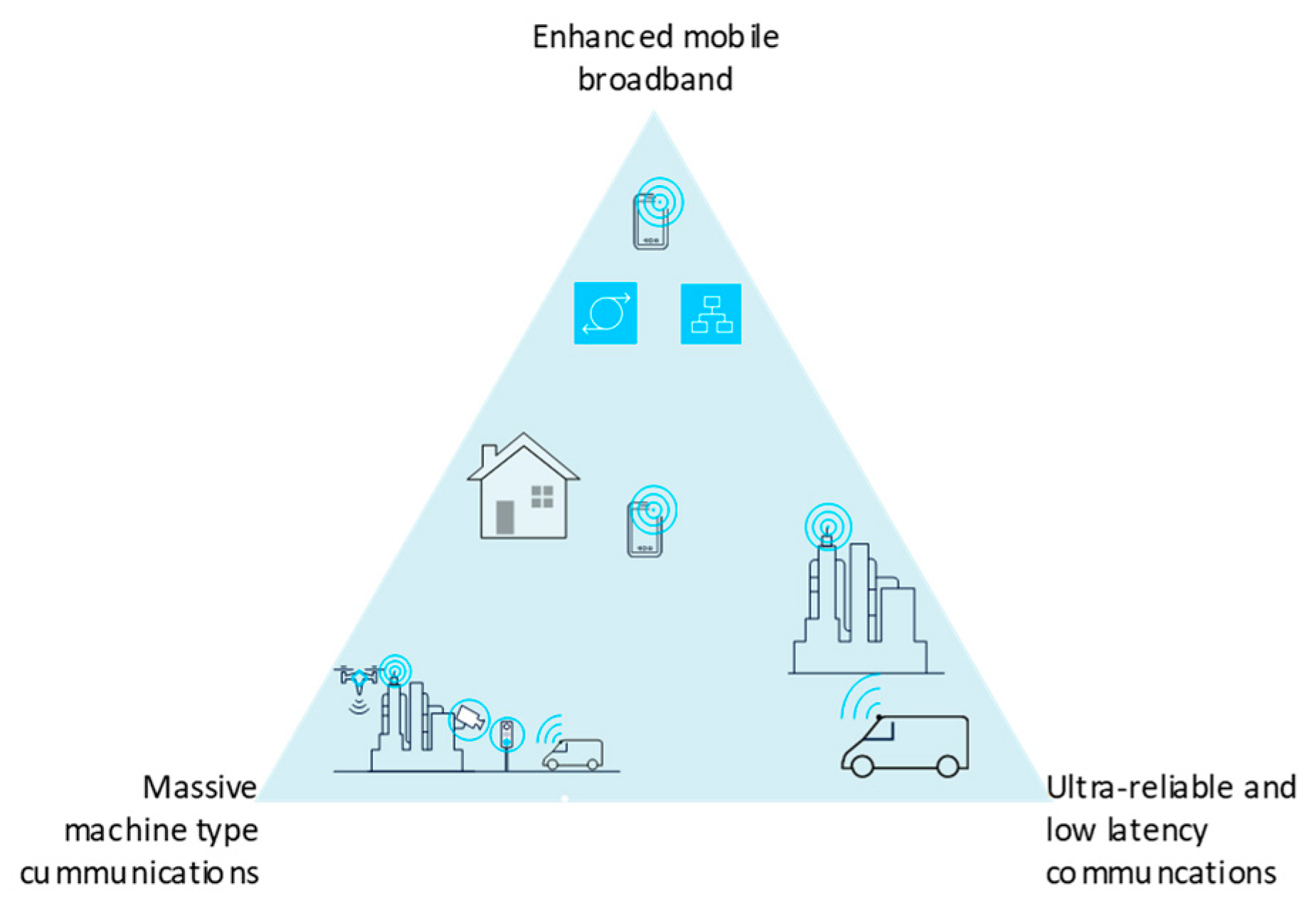
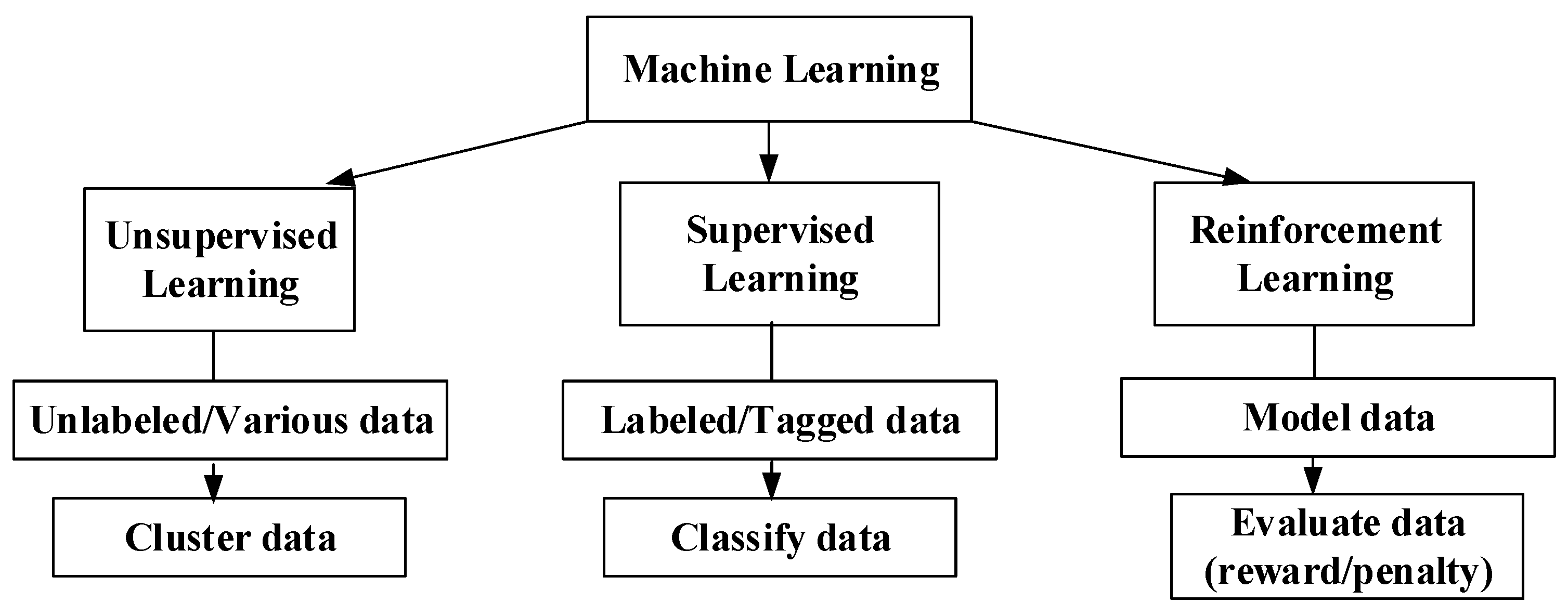
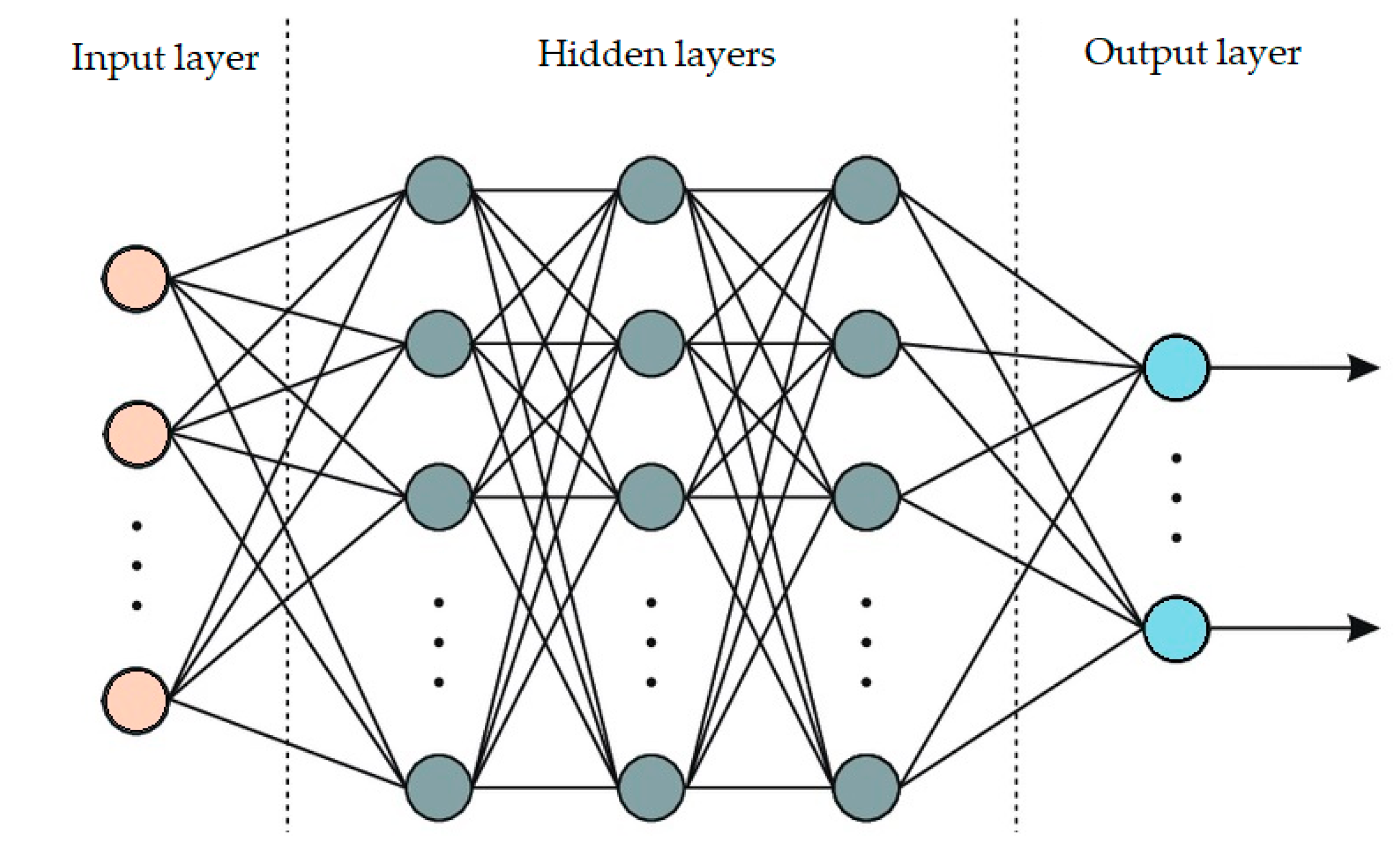
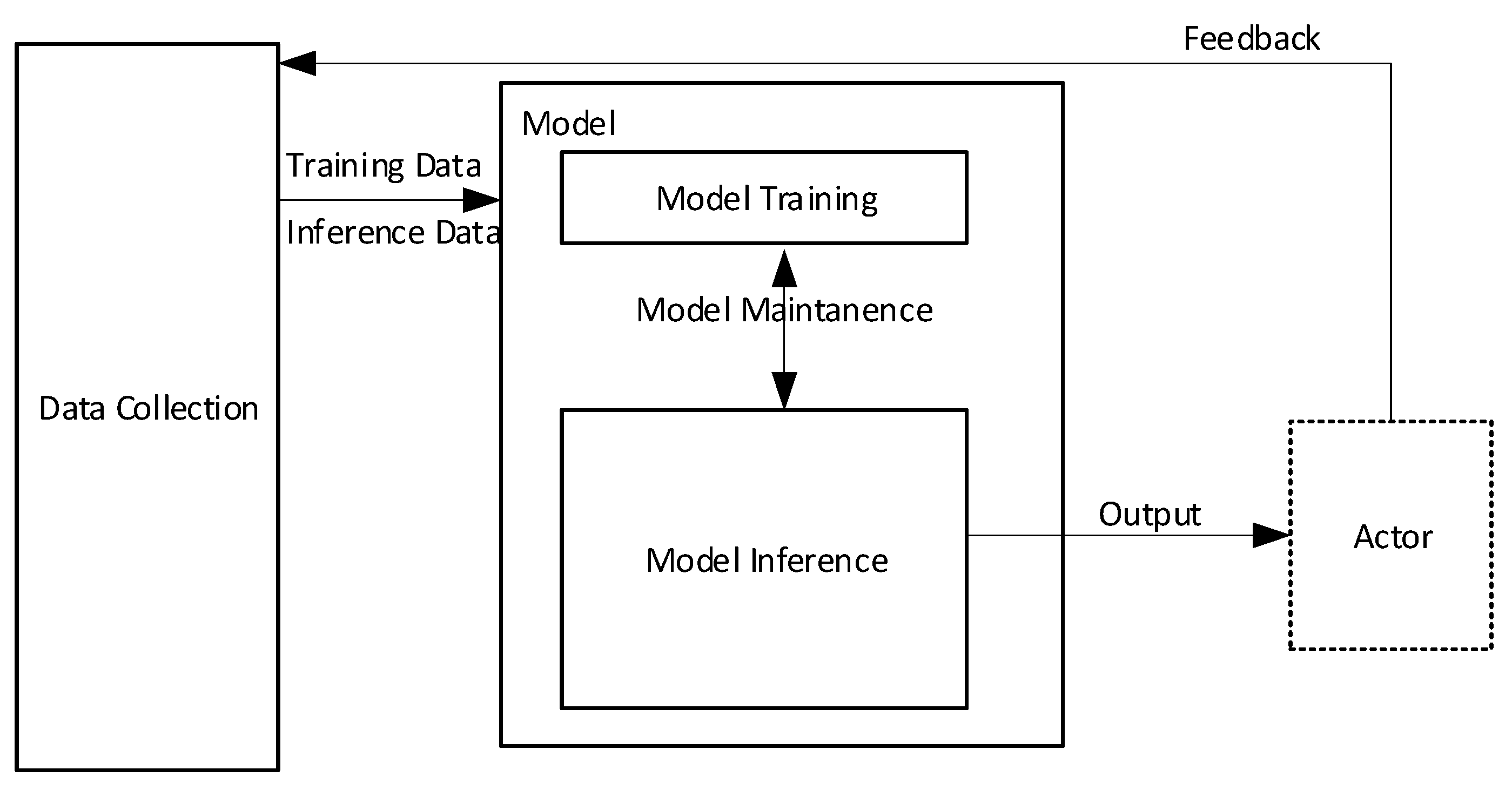
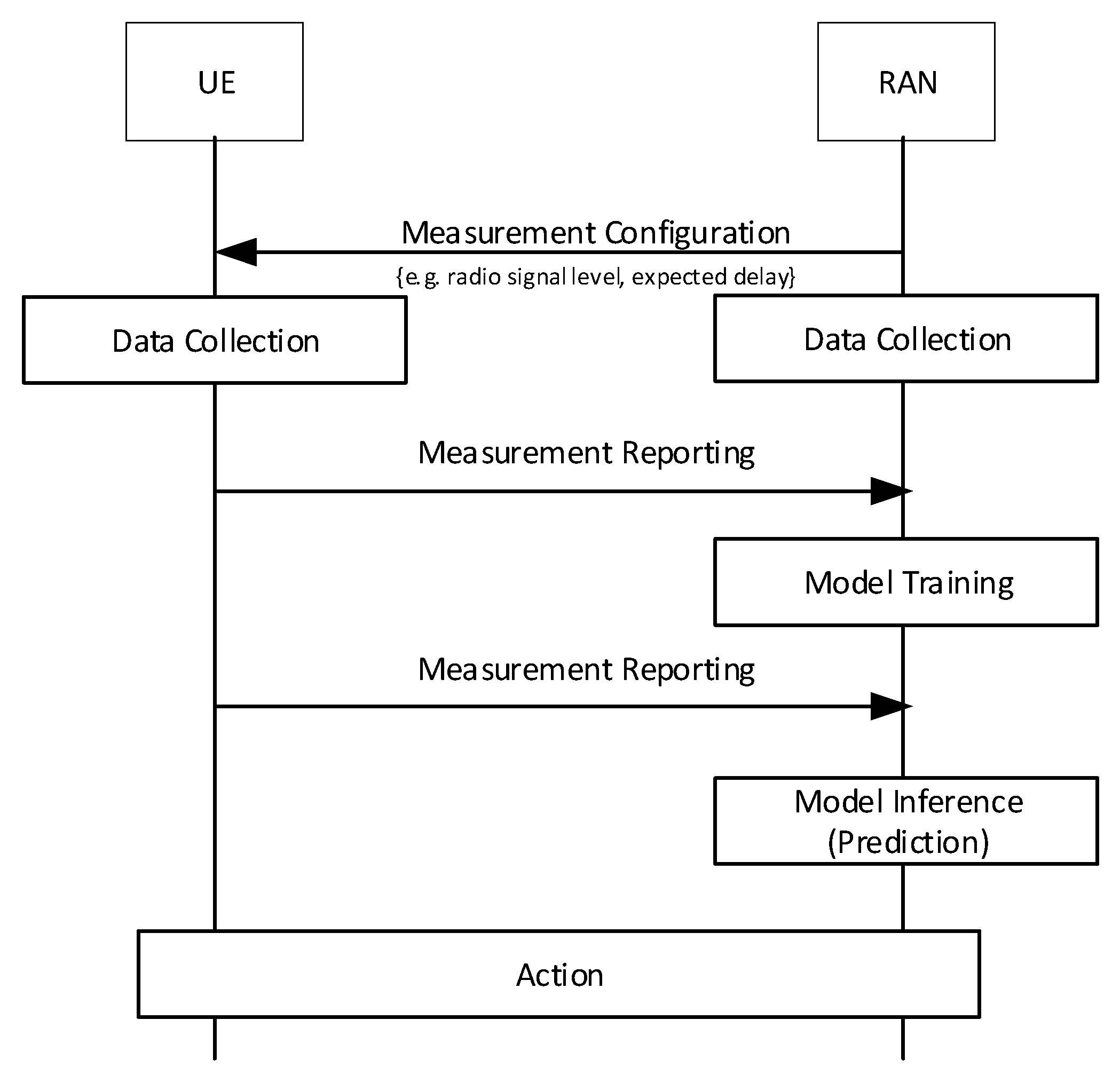

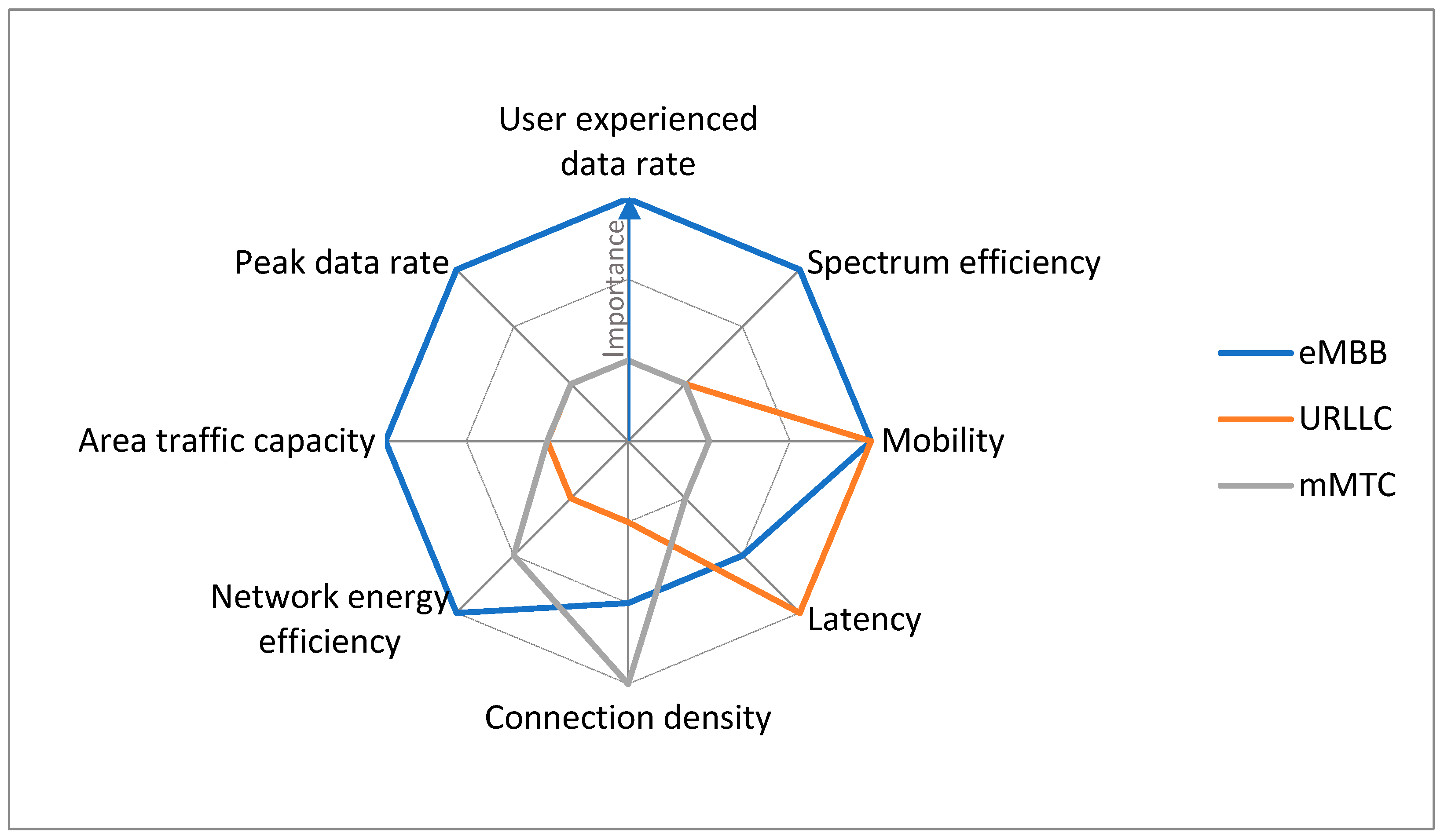
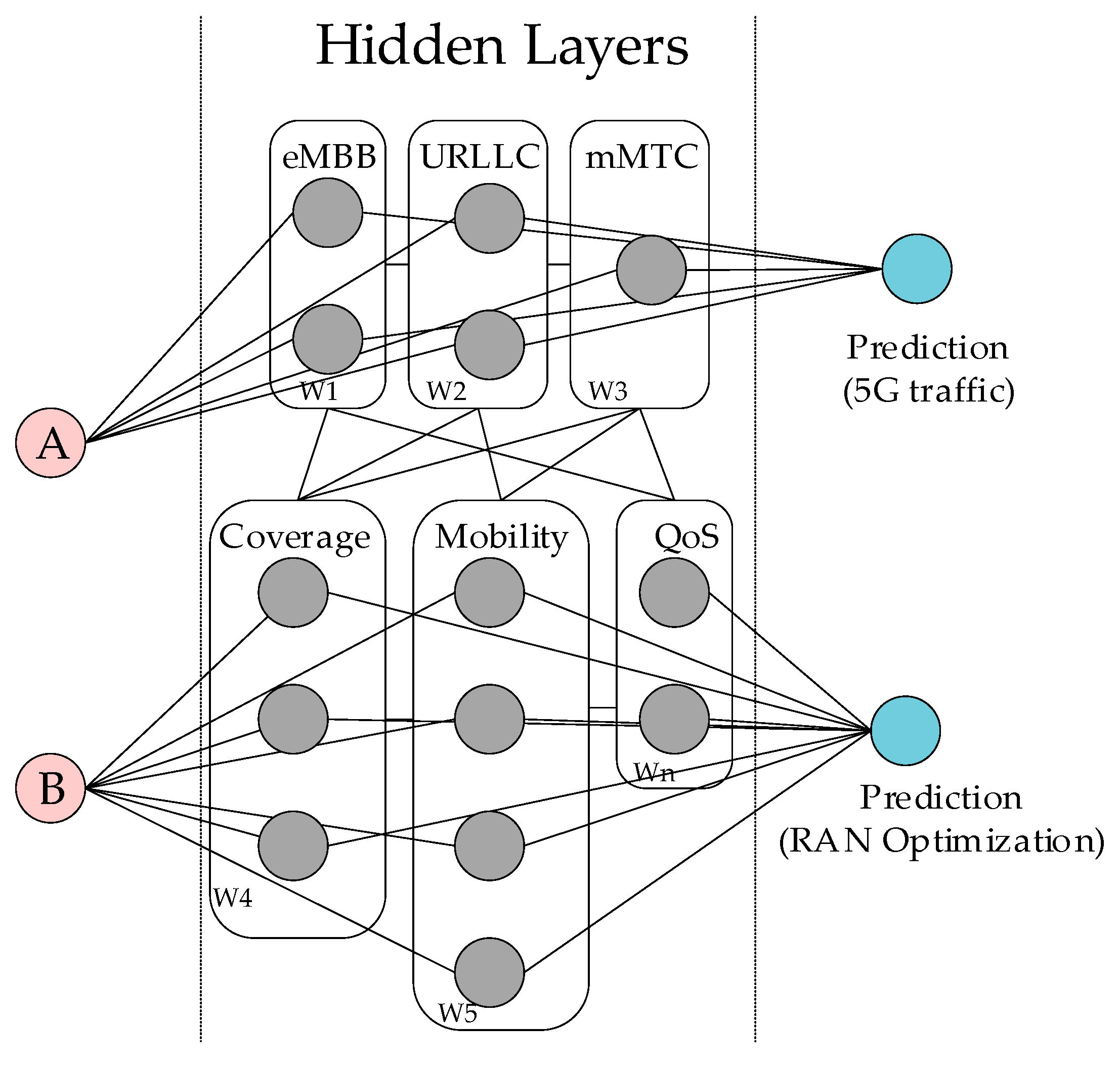
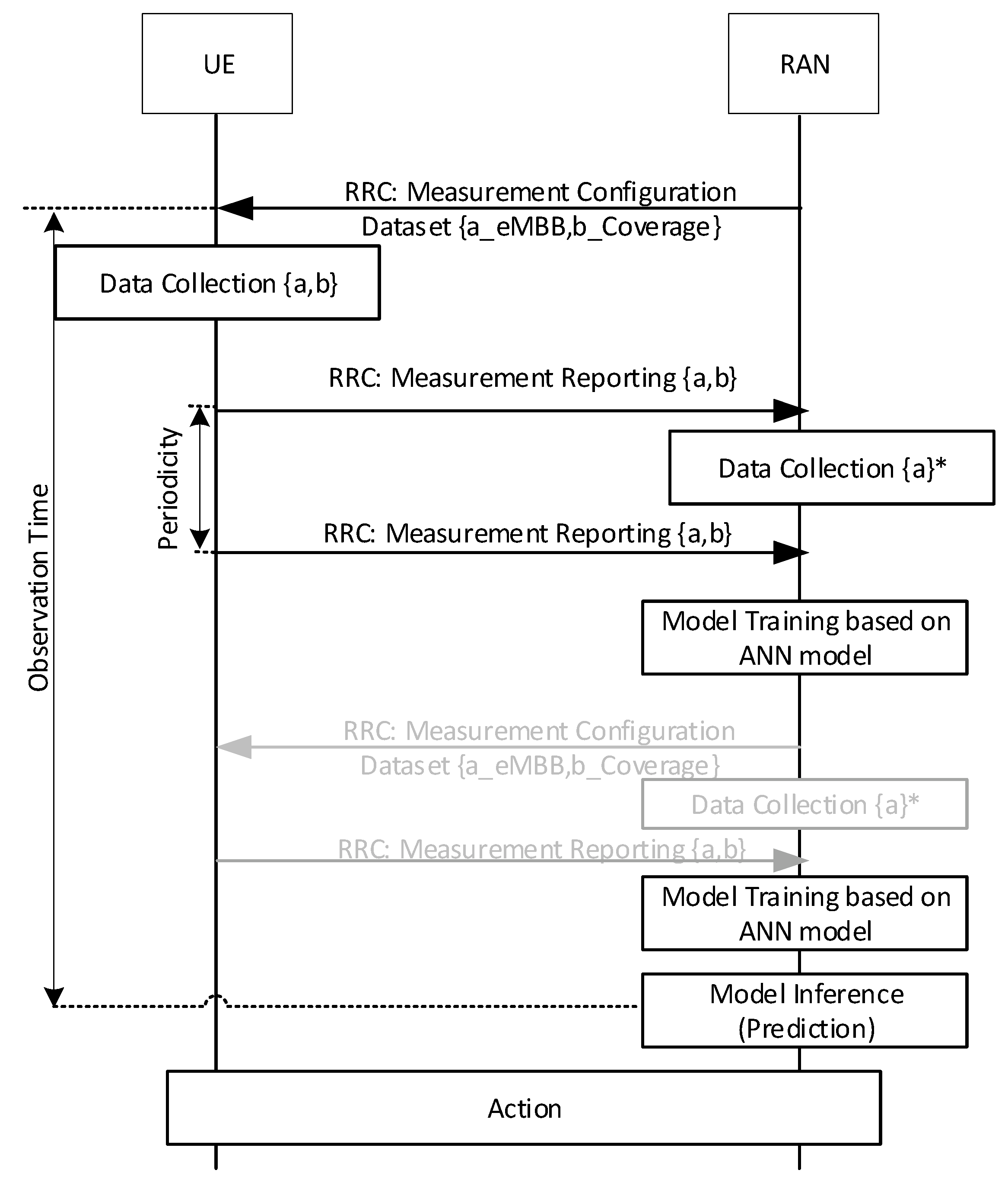
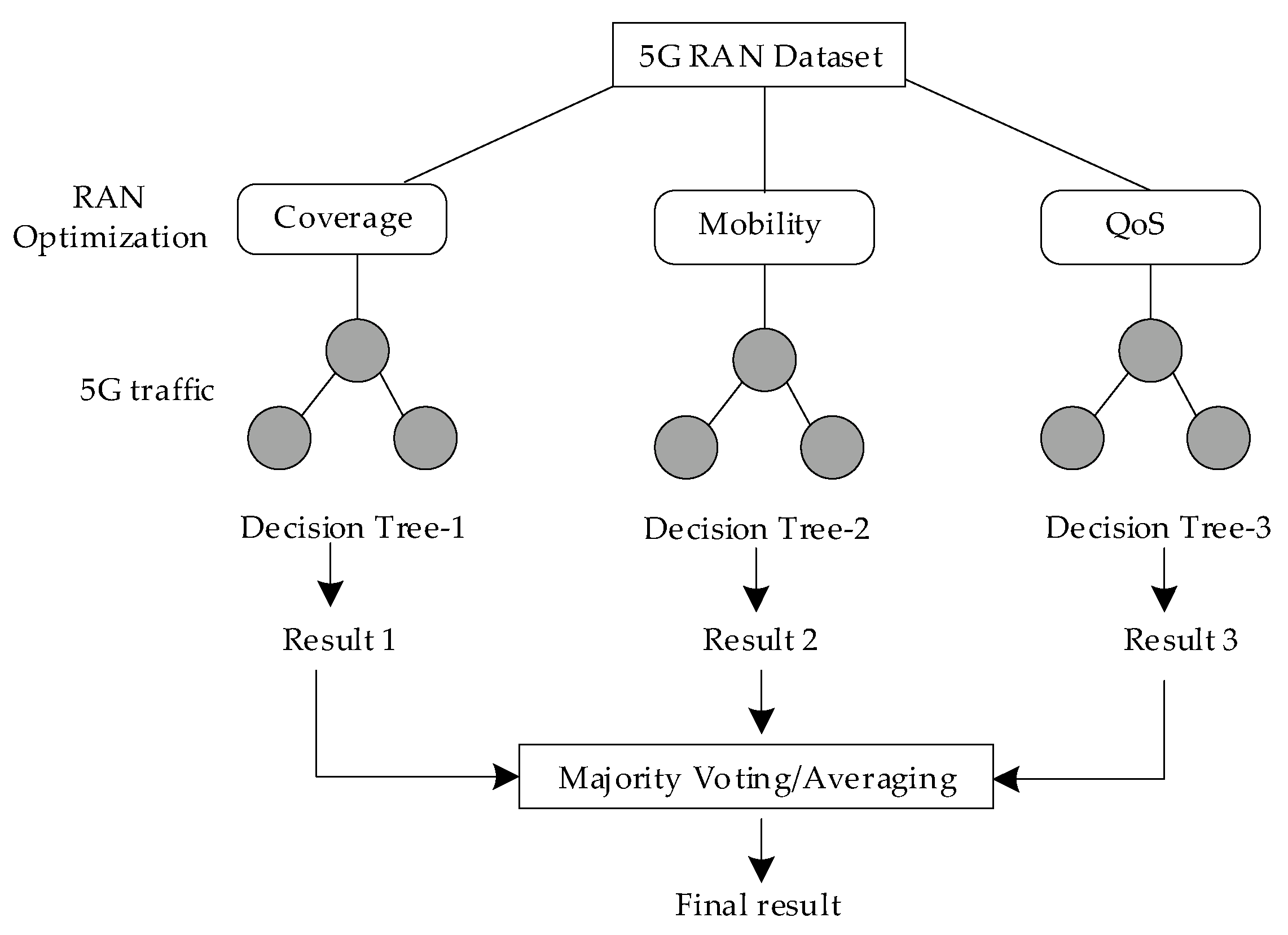
| eMBB | URLLC | mMTC |
|---|---|---|
| Peak data rate | Latency | Connection density |
| User experience data rata | Mobility interruption time |
| Coverage Optimization | Mobility Optimization | QoS Optimization |
|---|---|---|
| RSRP, RSRQ, SINR | RSRP, RSRQ, SINR | Latency |
| Interruption time | Throughput |
| Radio Conditions | RSRP (dBm) | RSRQ (dB) | SINR (dB) |
|---|---|---|---|
| Excellent | ≥−80 | ≥−10 | ≥20 |
| Good | −80 to −90 | −10 to −15 | 13 to 20 |
| Medium | −90 to −100 | −15 to −20 | 0 to 13 |
| Poor | ≤−100 | <−20 | ≤0 |
| Performance Indicator | Use Case | Target Value |
|---|---|---|
| Peak Data Rate | eMBB | Downlink 20 Gbit/s |
| Uplink: 10 Gbit/s | ||
| User Experience Data Rate (Throughput) | eMBB QoS | Downlink 100 Mbit/s |
| Uplink: 50 Mbit/s | ||
| Mobility interruption time | URLLC Mobility | 0 ms |
| Latency | URLLC QoS | Control Plane: 20 ms |
| User Plane: 1 ms | ||
| Connection density | mMTC | 1 000 000 devices per km2. |
| Radio signal level | Coverage Mobility | RSRP > −90 dBm |
| RSRQ > −15 dB | ||
| SINR > 13 dB |
Disclaimer/Publisher’s Note: The statements, opinions and data contained in all publications are solely those of the individual author(s) and contributor(s) and not of MDPI and/or the editor(s). MDPI and/or the editor(s) disclaim responsibility for any injury to people or property resulting from any ideas, methods, instructions or products referred to in the content. |
© 2023 by the authors. Licensee MDPI, Basel, Switzerland. This article is an open access article distributed under the terms and conditions of the Creative Commons Attribution (CC BY) license (https://creativecommons.org/licenses/by/4.0/).
Share and Cite
Tomala, M.; Staniec, K. Modelling of ML-Enablers in 5G Radio Access Network-Conceptual Proposal of Computational Framework. Electronics 2023, 12, 481. https://doi.org/10.3390/electronics12030481
Tomala M, Staniec K. Modelling of ML-Enablers in 5G Radio Access Network-Conceptual Proposal of Computational Framework. Electronics. 2023; 12(3):481. https://doi.org/10.3390/electronics12030481
Chicago/Turabian StyleTomala, Malgorzata, and Kamil Staniec. 2023. "Modelling of ML-Enablers in 5G Radio Access Network-Conceptual Proposal of Computational Framework" Electronics 12, no. 3: 481. https://doi.org/10.3390/electronics12030481
APA StyleTomala, M., & Staniec, K. (2023). Modelling of ML-Enablers in 5G Radio Access Network-Conceptual Proposal of Computational Framework. Electronics, 12(3), 481. https://doi.org/10.3390/electronics12030481









